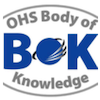Chapter 5.2: The Science of Safety
Abstract
While the ‘science of safety’ is often referred to in professional discussion there has not been any clear exposition of the theories and principles that make up that science. Drawing on the book Foundations of Safety Science, this chapter briefly reviews each decade from the 1900s through to the 2010s summarising the predominant safety theories of the time, how they interact and how they are reflected in practice then and now. While the system within which people work is overtly the focus of most of the theories, perspectives from each theory are presented to demonstrate that they actually revert to target the people who work in the system. The chapter concludes that whilst the basis is preliminary and flawed, safety has status as a social science which should inform OHS practice.
Keywords: safety, theory, science, system, people
First year of publication: 2019
Current Version: 2019
Chapter 5.2: The Science of Safety
Table of contents
1 Introduction
2 An episodic view of the development of the science of safety
2.1 The early 1900s
2.2 The 1910s: Taylor and proceduralisation
2.3 The 1920s: Accident-proneness
2.4 The 1930s: Heinrich and behaviour-based safety
2.5 The 1940s: Human factors and cognitive systems engineering
2.6 The 1950s and 60s: System safety
2.7 The 1970s and 80s: Man-made disasters, normal accidents and high reliability organisations
2.8 The 1980s and 90s: Swiss cheese and safety management systems
2.9 The 2000s: Safety culture
2.10 The 2010s: Resilience engineering
3 People in the system
4 Safety as a social science
5 A postscript
References
Professor Sidney Dekker, Director, Safety Science Innovation Lab, Griffith University
Sidney gained his PhD from Ohio State University, USA in 1996. In addition to his role at Griffith University in Brisbane, Australia he is a Professor at the Faculty of Aerospace Engineering at Delft University in the Netherlands. As well as his academic roles, Sidney has recently been flying the Boeing 737 as airline pilot and he is a film maker (‘Safety Differently,’ 2017; ‘Just Culture,’ 2018) and bestselling author of, most recently: Foundations of Safety Science (2019); The Safety Anarchist (2018); The End of Heaven (2017); Just Culture (2016); Safety Differently (2015); The Field Guide to Understanding ‘Human Error’ (2014); Second Victim (2013); Drift into Failure (2012); Patient Safety (2011), and co-author of Behind Human Error (2010).
Learning Outcomes: The Organisation
The OHS Body of Knowledge takes a conceptual approach which enables it to be applied in different contexts and frameworks.
To optimise its value for education and professional development learning outcomes have been developed for each technical chapter in the Body of Knowledge.
The learning outcomes as described give an indication of what should be the capabilities of an OHS professional; it is up to those developing OHS education programs, OHS professionals planning their CPD or recruiters or employers selecting or developing people for the OHS function to consider the required breadth vs. depth .
Please read the section on using the learning outcomes before delving into the leaning outcomes of the individual chapters.
The numbers against each learning outcome refer to the chapter number of the BOK download page. No learning outcomes have been developed for the chapters considered introductory or underpinning knowledge (that is chapters 1, 2, 3, 4, 5, 6, 7, 1, .13, 14, 15.)

